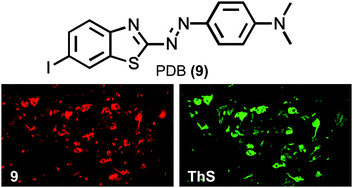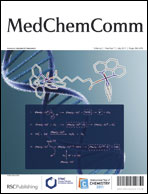This paper describes the synthesis and biological evaluation of novel phenyldiazenyl benzothiazole (PDB) derivatives as probes for imaging neurofibrillary tangles (NFTs) in patients with Alzheimer's disease (AD). We successfully synthesized three PDB derivatives using a diazo coupling reaction. In binding experiments in vitro, the compounds displayed higher affinity for tau aggregates than for Aβ aggregates. In fluorescent staining experiments using AD brain sections, 9 visualized NFTs clearly. No-carrier-added radioiodinated PDB derivatives were successfully prepared through an iododestannylation reaction from the corresponding tributyltin derivatives. [125I]9 labeled NFTs in sections of brain tissue from a patient with AD, but not a control. In biodistribution experiments using normal mice, the PDB derivatives displayed an uptake into the brain, sufficient for imaging NFTs, ranging from 0.94 to 3.2% ID g−1, but a relatively slow washout. Although further modifications are necessary to improve the pharmacokinetics in the brain, PDB with high affinity for tau aggregates may be useful as a backbone structure to develop agents for imaging NFTs in AD brains.

You have access to this article
 Please wait while we load your content...
Something went wrong. Try again?
Please wait while we load your content...
Something went wrong. Try again?


 Please wait while we load your content...
Please wait while we load your content...